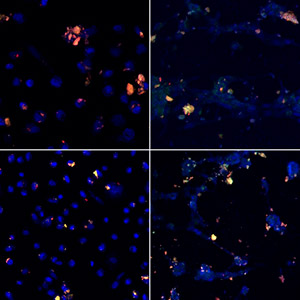Cancer of prostate
The new medicine has shown 15 times more anti-tumour activity than docetaxel, the most commonly used treatment that is resistant to hormonotherapy
[ 16/09/2020 ]
Prostate cancer is the most common type of cancer among European men; its incidence surpasses 100 cases per 100,000 people. Furthermore, it is currently the second most common cause of death by cancer among men. Researchers of the Institute of Chemical Technology (ITQ), a mixed centre of the Polytechnic University of Valencia (UPV) and the Spanish National Research Council (CSIC) have developed and patented a new nanomedicine for its diagnosis and treatment (theranostic system), based on the use of organic porous nanoparticles called COFs – covalent organic frameworks – which stand out for being more efficient and less aggressive than conventional chemotherapy.
Through specific antigen-antibody interactions, it enables the selective destruction of cancerous cells in the prostate gland and the local lymph nodes. It is comprised by a COF nanoparticle which contains the molecule of a therapeutic agent – in this case docetaxel, the most commonly used medicine for treating prostate cancer that is resistant to hormonotherapy -, an anti-FOLH1 monoclonal antibody, which selectively interacts with the FOLH1 membrane receptors of prostate cancer cells, and an imaging agent, which is generally a radionuclide for positron emission tomography, PET.
Intra-tumour administration
The administration protocol of this theranostic nanomedicine is also innovative, as it is administered in an intra-tumour way, which limits its effect on the rest of the body, minimising the secondary effects of docetaxel: it solves the toxicity issues generated by the intravenous administration of docetaxel, whose high systemic toxicity limits both the doses and the duration of the therapy, which in turn significantly decreases its anti-tumour efficiency.
“With our nanomedicine, the required dose is lower than in conventional chemotherapy, and its therapeutic effect is greater. In the in-vitro studies on prostate cancer cells, the system has managed to improve the anti-tumour activity of docetaxel by a factor of 15,” says Pablo Botella, scientist at the Institute of Chemical Technology of the CSIC.
Other advantages
The theranostic system also enables the identification of tumour cells and their destruction at the same time, which helps monitor the evolution of the cancer and the specificity of the treatment simultaneously. All this is possible thanks to the use of a molecule that guides it to specific receptors in tumour cells and the PET imaging technique, which helps locate the malign tissue in the prostate with unicellular accuracy, which facilitates diagnosing the disease in its first stages.
Furthermore, the releasing of the therapeutic agent can be monitored for several hours or days, as well as the nanoparticle used, which is 100% organic, and also totally biodegradable (unlike others of an inorganic or hybrid nature), which facilitates its full disposal.
Outstanding news
 Study a degree at the best technological university in Spain
Study a degree at the best technological university in Spain
The Universitat Politècnica de València is ranked number 1 among Spanish technology universities, according to the Shanghai ranking
 National Research Award
National Research Award
Ramón Martínez Máñez has received the "Juan de la Cierva" National Research Award in the area of Knowledge Transfer
 The UPV and Beihang University strengthen their academic and scientific alliance
The UPV and Beihang University strengthen their academic and scientific alliance
The two universities have signed a new collaboration agreement as part of the celebration of "UPV Day" in China
 Study in English
Study in English
The UPV offers eight degrees, 16 master's and 650 courses in English for the 2025-26 academic year
 THE Impact Ranking
THE Impact Ranking
The UPV, the Spanish university with the greatest social and economic impact in the world






